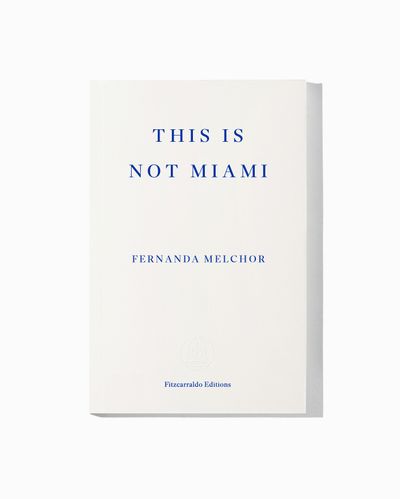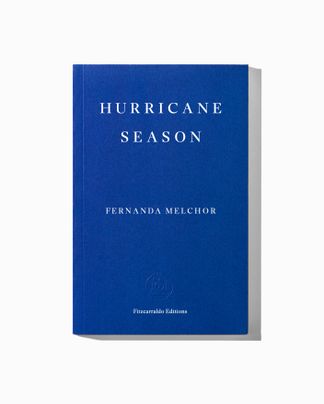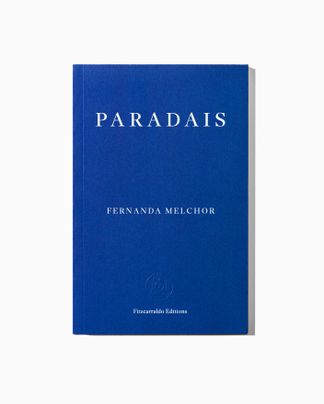Set in and around the city of Veracruz in Mexico, This Is Not Miami delivers a series of devastating stories – spiralling from real events – that bleed together reportage and the author’s rich and rigorous imagination. These crónicas – a genre unique to Latin American writing that blends reportage, narrative non-fiction and novelistic forms – probe deeply into the motivations of murderers and misfits, into their desires and circumstances, forcing us to understand them – and even empathize – despite our wish to disdain them as monsters. As in her hugely acclaimed novels Hurricane Season and Paradais, and once again brilliantly translated by Sophie Hughes, Fernanda Melchor’s masterful stories show how the violent and shocking aberrations that make the headlines are only the surface ruptures of a society on the brink of chaos.

This Is Not Miami
Translated by Sophie Hughes
French paperback with flaps, 160 pages
Published 10 May 2023
This Is Not Miami
Translated by Sophie Hughes
LIGHTS IN THE SKY
In the early nineties, Playa del Muerto, or Dead Man’s Beach, was little more than a strip of greyish sand located in the city of Boca del Río, a city in the municipality of the same name, just south of Veracruz. Its scorching dunes were covered in thorny shrubs, which were littered with rotten branches and plastic bottles that the river dragged down from the mountains when the waters were high. It wasn’t a busy or particularly pretty beach (if any of the beaches in this part of the Gulf of Mexico can said to be truly pretty) and there were times – especially during high tide or storms – when the sand would disappear entirely and not even the breakwaters could prevent the waves from crashing onto the highway connecting the two cities.
The locals avoided Dead Man’s Beach. Every year dozens of intrepid bathers, most of them visiting from Mexico City, met their death in those treacherous waters. ‘No swimming’, read a sign a few feet from the water. ‘Bewear, deep pools’ warned a crudely painted red skull. The powerful undertow that dragged the estuary waters towards the headland in Antón Lizardo left Playa del Muerto dotted with inshore holes, depressions on the seafloor that caused unpredictable underwater currents where it was easy to drown.
I was nine years old when I spotted the lights, as bright as fireflies against the black canvas of the beach. My fellow witness was my brother Julio, who was six months shy of his seventh birthday. We were busy demolishing the home of a blue crab, poking around in the sand with a stick, when a sudden flash in the sky caught our attention. Five bright lights appeared to rise up out of the sea before floating for a few seconds above our heads and then shooting off inland, in the direction of the estuary.
‘Did you see that?’ Julio said, pointing at the horizon.
‘Obviously. I’m not blind,’ I replied.
‘What was it?’
‘It was a spaceship,’ I told him, awestruck.
But when we ran back to the bonfire to tell the adults, none of them took any notice, not even our parents. Set back slightly from the fire and the rest of the group, they were arguing so heatedly they didn’t even want to hear us.
Some weeks earlier, on Thursday, 11 July 1991, an incredible event had taken place, one that would come to beknown as ‘the longest solar eclipse of the twentieth century’. That afternoon, all eyes were on the skies as Mexico impatiently awaited the miraculous transformation of the sun into a ring of fire and the moon into a great black blotch. The eclipse wouldn’t be visible from Veracruz, but what did we care: we had the TV, which was repeating on loop one static image of the sky and several scenes of people in cities around the world where the phenomenon would be visible to the naked eye: thousands gathered in town squares and on beaches, crammed onto rooftops and central reservations, all looking up at the sky with cardboard periscopes and special glasses. The newsreaders were continuously reminding viewers how dangerous it was to look directly at the eclipse: you could burn your retinas and be blinded for life. I kept thinking how lucky it was that Veracruz was outside of the path of totality, because I knew I wouldn’t be able to help myself from looking at that perturbing black sun, and that its intense glare would probably melt my eyes like wax, or at least that’s what I imagined.
I had no idea at the time, but while my family and I were glued to the TV in my grandmother’s room watching the eclipse, a man named Guillermo Arreguín had set himself and his video camera up on the balcony of his home, south of the Periférico beltway in Mexico City. Guillermo Arreguín wasn’t as interested in the ecliptic climax as in the planets, stars, and other celestial bodies, which, according to an astronomy magazine he’d read, would shine especially brightly thanks to the forced twilight. When darkness fell, Arreguín panned his camera lens back and forth several times from one end of the balcony to the other. During one of these shots he’d captured a strange object that appeared to be floating above the surrounding buildings.
(…)
‘The result is an absorbing, compassionately rendered portrait of a place, its people and its ills. The stories are punctuated by brief but telling allusions to the material conditions that sustain the moral degradation she describes: police corruption, social security cuts, prison overcrowding, unscrupulous building contractors. Melchor’s macabre aesthetic has shades of gothic horror, but she is a Dickensian at heart.’
— Houman Barekat, Sunday Times
‘Fernanda Melchor has a powerful voice, and by powerful I mean unsparing, devastating, the voice of someone who writes with rage and has the skill to pull it off.’
— Samanta Schweblin, author of Fever Dream
‘Time spent with her writing leaves no doubt: the unholy noise she creates is the work of someone who knows exactly which notes to hit.’
— Chris Power, Guardian
‘Don’t get too hung up on what exactly This Is Not Miami is, though, and you’ll find its world filthy, disquieting and compulsive.’
— Pippa Bailey, New Statesman
‘Melchor evokes the stories of Flannery O’Connor, or, more recently, Marlon James’s A Brief History of Seven Killings. Impressive.’
— Julian Lucas, New York Times
‘She isn’t holding a Stendhalian mirror up to Mexican society; she’s dissecting its body and its psyche at the same time, unafraid of what she might find…. In Melchor’s world, there’s no resisting the violence, much less hating it. All a novelist can do, she seems to suggest, is take a long, unsparing look at the hell that we’ve made.’
— Juan Gabriel Vázquez, New Yorker
‘In addition to bravely presenting dark truths, Melchor writes from a good heart…. Melchor makes her point (not without sorrow and gruesome humor), then gets out of the way, so that her subjects can speak.’
— William T. Vollmann, New York Times
‘Melchor isn’t inventing anything in broad strokes…. She’s not playing with facts so much as how facts are delivered – oral history, first person, second person, ghost story, legend. A lesser journalist massages details to more perfectly fit a narrative. Melchor is doing something more like the opposite: playing with form to expose the lies, hypocrisies, hatreds and oversights that soften or avoid the reality of human evil. Melchor isn’t claiming to know the whole story. But what she means to say is that we should think twice before we do as well.’
— Mark Athitakis, Los Angeles Times
‘Skillfully translated by Hughes, this is a book that’s as gorgeous as it is dark, and it proves that Melchor is one of the finest writers working today. Absolutely stunning.’
— Kirkus starred review
‘Melchor resists the seductive burden of explaining the realities (or exaggerations) of such non-European regions in blistering, true-crime detail. Though based on real events, these relatos are decidedly not journalistic, and not even realist. Melchor’s prose blooms under that strange light.’
— Lisa Yin Zhang, Frieze
‘Translator Sophie Hughes has performed another heroic feat in rendering Melchor’s winding sentences into breathtakingly stylish English. These stories, packed with dismembered limbs and immolation, are not for the faint-hearted, but Melchor’s writing offers a special, twisted kind of beauty.’
— Michael Delgado, i News
‘In finding a narrative for those who are rarely given literary or any other kind of airtime, and in writing in a vernacular that acknowledges the cruelty that lurks in the language of neutral observation, Melchor writes a new kind of folklore that allows us to hear the ferocious reality of contemporary violence.’
— Jess Cotton, Jacobin
‘Seamlessly translated by Sophie Hughes from the initial Spanish, This Is Not Miami is a compelling read. However, be warned; these tales may well devour your dreaming.’
— Annie Hayter, Big Issue
‘In a country where corruption runs rampant, where the official story from the police or the government is tainted, inadequate, or missing altogether, This Is Not Miami functions as a counternarrative: Melchor presents a corrective simply by getting close to her subjects and telling their stories one by one, often in their own voices.This Is Not Miami makes clear just how grounded the heightened drama of Hurricane Season and Paradais is. The connections between Melchor’s fiction and nonfiction go beyond the subject matter – poverty and superstition, misogyny and sexual violence – and include how a story can be corrupted as it passes from person to person.’
— Laura Adamczyk, The Nation
Born in Veracruz, Mexico, in 1982, Fernanda Melchor is widely recognized as one of the most exciting new voices of Mexican literature. Hurricane Season was shortlisted for the 2020 International Booker Prize and longlisted for the National Book Award. Paradais, her second novel to appear in English, was longlisted for the 2022 International Booker Prize.
Sophie Hughes translates Spanish and Latin American authors. She was shortlisted for the International Booker Prize in 2019 and 2020, and in 2021 she was awarded the Queen Sofía Translation Prize.





